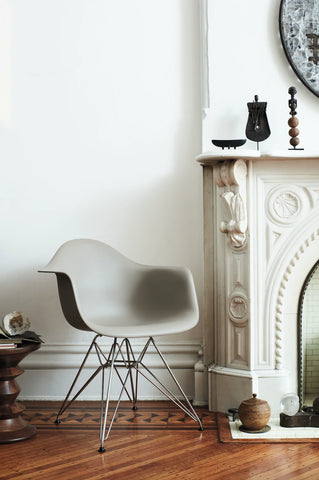Spotlight On: Charles & Ray Eames
“The role of the designer is that of a very good, thoughtful host anticipating the needs of his guests.” - Charles Eames

It is fair to say that the world of design would not be what it is without the iconic and expansive influence of Charles and Ray Eames. Known for their wide reach within the artistic realm, the Eameses were often on the frontlines of the creative process. They enjoyed taking their architectural and artistic foundations and experimenting with new materials, applying their collective expertise to a number of industries. With their hearts set on creating environments where everyone thrived, Charles and Ray Eames became legendary figures within their field, shaping it for generations to come.
From the Beginning
Charles and Ray met at the Cranbrook Academy of Art where Charles was working with architect Eero Saarinen and acting as director of the school’s industrial design program. The two quickly became partners – marrying in 1941 and establishing the Eames Office not long after. From the beginning, Charles and Ray improved everything they touched – from plywood, to plastic, to cardboard boxes. During WWII, they utilized their knowledge of plywood molding to develop turned splints, stretchers, and airplane parts for the war effort. From there, the Eames Office blossomed, and their work flourished.

Endless Influence
Throughout their careers, Charles and Ray Eames practiced a holistic approach to design, applying their prowess to ventures that brought them creative joy. This led to a variety of projects spanning the spectrum of artistic media including the production of short films. Themes included everything from the construction of flat-packed furniture, to the “how-it’s-made” design process of their fiberglass chairs.
Determined to spark and foster imagination, they ventured into the children’s toys realm. With their eye on serious fun, Charles and Ray turned delivery boxes into an entire play town where children could explore and build a space of their own. They used their plywood molding techniques to create animal shaped chairs (which included an elephant, horse, and bear), made kites, decks of cards, and a toy model house kit that came in a ¾-inch scale and included an entire set of miniature Eames furniture and accessories.

Perhaps most importantly, Charles and Ray Eames developed affordable and comfortable seating for the masses in the form of the Eames Molded Plastic Chairs and Eames Molded Fiberglass Chairs. These humble accent chairs offer a modest silhouette and boundless versatility. Borne of their dutiful exploration of molded plywood and innovative work with fiberglass, the Eames’s shell chair concept has become an interior design and architectural staple, adapting to nearly every commercial and domestic room’s style and purpose. The aim of the shell chair was to capture the natural mottling, surface variation, tone, and texture of the materials and integrate them into a practical chair. Maintaining the original Charles Eames furniture design vision for the shell chair, Herman Miller® has re-created the shell chair with upgraded manufacturing processes, establishing the Eames molded chairs as centerpieces of the Herman Miller collection.

Eames® Lounge Chair and Ottoman
For more than half a century the Eames Lounge Chair and Ottoman have endured as one of the most iconic lounge chair designs. The jewel in the crown of the Eames’s careers, the Eames Lounge Chair has become synonymous with luxury. Easily recognized, the Eames Lounge Chair utilizes the signature molded plywood to envelope cushions, and the structure is segmented to allow movement and the familiar curved recline. Charles and Ray wanted the Eames Lounge to arrive on the user’s doorstep already exuding comfort, so the leather upholstery comes already wrinkled and soft, and the chair is always accompanied by an ottoman. This chair holds such a treasured place in the world of design that, on its fiftieth anniversary of release, a group of design scholars came together to write The Eames Lounge Chair: An Icon of Modern Design.
Lasting Legacy
Today, Charles and Ray Eames’s “cheerful and charming, informative and innovative” legacy lives on in not only the design industry and recognizable designs, but in the 750,000 prints and photographs in the Library of Congress, the work of countless artists and musicians who cite them as inspiration, museum exhibits, and the preservation work of the Eames House and Foundation.




























































































































